An interview with Ian Craigie.
The big mammals for which Africa is so famous are vanishing in staggering numbers. According to a study published last year: Africa’s large mammal populations have dropped by 59% in just 40 years. But what is even more alarming was that the study only looked at mammal populations residing in parks and wildlife areas, i.e. lands that are, at least on paper, under governmental protection. Surveying 78 protected areas for 69 species, the study included global favorites such as the African elephant, giraffes, zebra, wildebeest, and even Africa’s feline king, the lion.
“We weren’t surprised that populations had dropped but we were surprised by how large the drops had been,” lead author Ian Craigie told mongabay.com in an interview.
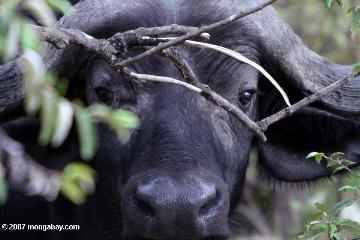 African buffalo in Maasai Mara park in Kenya. Photo by: Rhett A. Butler. |
Craigie says that there are a number of causes behind the observed declines, including agriculture, hunting, and the bushmeat trade. But all of them are due to human actions. In fact, he points to Africa’s population explosion as one of the underlying factors.
“In Africa man has successfully lived alongside large populations of wild animals for millennia but the advent of advanced technology and agriculture has lead to a 5-fold increase in African human populations since World War 2. All these extra humans are using and moving into previously natural habitats and squeezing out the wildlife,” he says.
The study looked at three general regions across Africa: Southern African, East Africa, and West Africa. Wildlife in Southern African parks fared the best according to Craigie because “the level of funding for parks in Southern Africa is much greater than other regions” and the region has lower population densities. West Africa’s parks came in last due to a culture of bushmeat hunting, poverty, and booming human populations.
The overall decline of African mammals is likely to be worse than even the study portrays for two reasons: mammal populations have almost certainly suffered worse outside of parks than inside, and Craigie and his team were not able to include parks that didn’t regularly survey their wildlife populations.
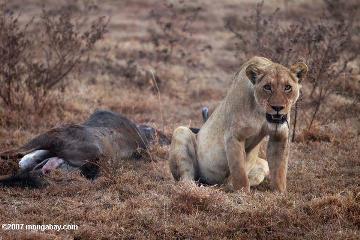 Lioness with wildebeest kill in Tanzania. Photo by: Rhett A. Butler. |
“The parks left out of this study, where animals were not counted, are likely to be those which are financially poorer or less well managed. So the large declines we found were from the best parks, if we were able to include the other parks the results may have been even worse,” Craigie explains.
In a January 2011 interview Dr. Ian Craigie discussed the state of mammal populations in parks across Africa, and how this loss impacts both the native ecosystems and the African people.
INTERVIEW WITH IAN CRAIGIE
Mongabay: What is your background?
Ian Craigie: I have just completed my PhD at the University of Cambridge and Institute of Zoology, London. I started the PhD having previously done a Masters at Imperial College London in 2006 and working for South African National Parks in 2004/2005.
AFRICAN MAMMAL DECLINES
Mongabay: Your study found that on average large mammal populations have dropped by 59 percent in Africa’s protected areas. Were you surprised by these findings?
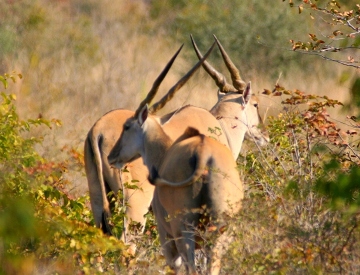 Common eland in Zimbabwe. Photo by: Tiffany Roufs. |
Ian Craigie:We weren’t surprised that populations had dropped but we were surprised by how large the drops had been and how consistent the drops were.
Mongabay: Why do you think this might even underestimate total declines?
Ian Craigie:We were only able to obtain data from parks that count their animals regularly. The parks left out of this study, where animals were not counted, are likely to be those which are financially poorer or less well managed. So the large declines we found were from the best parks, if we were able to include the other parks the results may have been even worse.
Mongabay: How could these declines be affecting the overall ecosystem?
Ian Craigie:The declines we found were mostly in herbivores such as wildebeest and impala. These species modify their environment through grazing which is an essential process in the ecosystem. Grazing drives the nutrient cycle, it controls the number and severity of fires and it even dictates whether habitats are grassland or woodland. Large declines in the number of grazers can lead to substantial changes in biodiversity and habitat structure.
Mongabay: Even though there’s not enough data to do a similar study of mammal populations outside of protected areas, what’s your sense of how mammals are doing there?
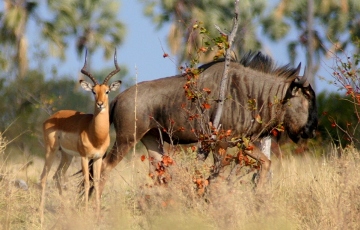 Wildebeest and a male impala in the Okavango Delta in Botswana. Photo by: Tiffany Roufs. |
Ian Craigie:It is hard to get a good feel of what’s happening outside parks but anecdotally many of the species we looked at are now virtually absent from areas outside parks. If you were to go on a safari holiday today you wouldn’t expect to see significant numbers of wildlife on your journey to the park until you reached the park gates.
CAUSES
Mongabay: What are the likely causes behind this decline?
Ian Craigie:There are multiple causes but they are all ultimately driven by mankind. Hunting and habitat damage through agricultural expansion are the two main culprits.
Mongabay: What role do you think population growth could be playing in the decline?
Ian Craigie:Human population growth underlies these declines by increasing the pressure that mankind puts on the environment. In Africa man has successfully lived alongside large populations of wild animals for millennia but the advent of advanced technology and agriculture has lead to a 5-fold increase in African human populations since WW2. All these extra humans are using and moving into previously natural habitats and squeezing out the wildlife.
Mongabay: Is there any evidence of climate change impacting mammals negatively, for example, with the extended drought in Kenya last year?
 Elephants at the Chobe River in Botswana. Photo by: Tiffany Roufs. |
Ian Craigie:It is highly unlikely that climate change has affected these animal populations. The declines we have observed go back 40 years and climate change has only very recently started to have a notable effect. Climate change is likely to affect these animal populations in the future by altering rainfall patterns in unpredictable ways, and causing droughts like the one you mentioned.
GOING FORWARD
Mongabay: Southern African mammals are doing better than East and West African. What is southern Africa doing right?
Ian Craigie:The level of funding for parks in Southern Africa is much greater than other regions of the continent and also there are generally lower human population densities.
Mongabay: West African mammals are the worse off of the three regions. What particular issues are mammals in West Africa facing?
Ian Craigie:West Africa still has a strong tradition of hunting for bushmeat, generally the countries in the region are poorer than the average for Africa and there are also high human population densities putting extra pressure on the natural resources.
Mongabay: What suggestions would you make in countering this decline or should we resign ourselves to a less wild Africa?
Ian Craigie:There is no doubt the patterns we have shown here can be reversed, the wildlife populations can recover if we reduce the threats they are facing, however it will require some serious investment and political will to achieve.
Mongabay: How would you like policymakers to view your study?
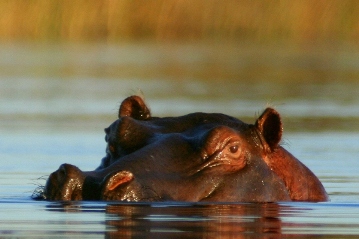 Hippos in the Okavango Delta in Botswana. Photo by: Tiffany Roufs. |
Ian Craigie:I would like policymakers to recognise the importance of monitoring conservation efforts, my study shows that parks aren’t working as well as we’d like. Policymakers should recognise the need to improve the performance of current conservation actions to get the best return for their investments
Mongabay: Why should the average African care about mammal populations falling?
Ian Craigie:Maintaining wildlife populations is important for maintaining tourist spending which is a major source of income for a number of African countries. The large mammal populations also perform a number of important natural functions and if these become disrupted it is hard to predict how the ecosystems will react. If ecosystems become disturbed this will in turn disrupt ecosystem services such as pollination or clean water provision which may directly affect local human populations.
Mongabay: What do your findings say about the capacity of protected areas worldwide to preserve biodiversity?
Ian Craigie:It is hard to generalise these results to other parts of the world, Africa is special in having large areas of savannah with millions of large mammals roaming around. In other areas that are forested or mountainous or have very different species there are likely to be quite different patterns of threats and species responses, and so parks are likely to vary in their performance a great deal.
Related articles
95% of Liberia’s elephants killed by poachers
(01/24/2011) Since the 1980s, Liberia has lost 19,000 elephants to illegal poaching, according to Patrick Omondi of the Kenya Wildlife Service speaking in Monrovia, the capital of Liberia. The poaching of Liberia’s elephants has cut the population by 95% leaving only 1,000 elephants remaining.
Last year worst yet for rhino killings in South Africa
(01/19/2011) Three hundred and thirty-three rhinos were killed in South Africa last year, the highest number yet. Ten of the rhino were black rhinos, which are listed as Critically Endangered by the IUCN Red List, the rest were white rhinos, listed as Near Threatened. In total South Africa has over 20,000 rhinos.
Mountain gorilla population up by 100 individuals
(12/07/2010) Conservation appears to be working for the Critically Endangered mountain gorilla (Gorilla beringei beringei) in the Virunga massif region, as a new census shows an additional 100 individuals from the last census in 2003, an increase of over a quarter. The Virunga massif is a region in three nations—Rwanda, the Democratic Republic of Congo, and Uganda—and covering three protected area.
Bushmeat hunting alters forest structure in Africa
(11/04/2010) According to the first study of its kind in Africa, bushmeat hunting impacts African rainforests by wiping-out large mammals and birds—such as forest elephants, primates, and hornbills—that are critical for dispersing certain tree species. The study, published in Biotropica, found that heavy bushmeat hunting in the Central African Republic changes the structure of forest species by favoring small-seeded trees over large-seeded, leading to lower tree diversity of trees that have big seeds.
Threatened on all sides: how to save the Serengeti
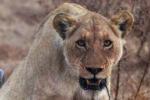
(09/27/2010) Tanzania’s plan to build a road through the Serengeti has raised the hackles of environmentalists, conservationists, tourists, and wildlife-lovers worldwide, yet the proposed road is only the most recent in a wide variety of threats to the Serengeti ecosystem. A new study in mongabay.com’s open-access journal Tropical Conservation Science looks at the wide variety of issues facing the Serengeti and how to save one of the world’s most beloved landscapes and wildlife communities.
21% of Africa’s freshwater plants and animals threatened
(09/02/2010) 21 percent of African freshwater plant and animal species are threatened with extinction, according to a five year assessment of 5,167 freshwater species by 200 scientists.
Lion populations plummet in Uganda’s parks
(08/19/2010) Lion populations across Uganda’s park system have declined 40 percent in less than a decade, according to the Wildlife Conservation Society (WCS).
Cameroon says goodbye to cheetahs and African wild dogs

(07/28/2010) Researchers have confirmed that cheetahs (Acinonyx jubatus) and African wild dogs (Lycaon pictus) have become essentially extinct in Cameroon. A three year study by the Institute of Environmental Sciences at Leiden University in the Netherlands found that the same factors that pushed cheetahs and African wild dogs to local extinction, have also left Cameroon’s other big predators hanging by a thread, including the lion, the leopard, and two species of hyena: the spotted and the striped.
Road through the Serengeti will eventually ‘kill the migration’

(07/08/2010) Tourists, conservationists, individuals, and tour companies have launched an international outcry against the Tanzanian authorities in response to the announcement of the planned construction of the trans-Serengeti Highway highway. There is even a Facebook group and an online petition with 5,038 signatures. But the government has responded by saying that the plans are still on course.
Saving one of West Africa’s last hippo populations
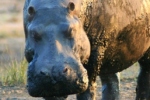
(06/28/2010) A new study in Tropical Conservation Science highlights the need for further conservation actions to save one of West Africa’s last hippo populations, located in southern Burkina Faso. Researchers surveyed 41 hippos in the ‘Mare aux Hippopotames’ Biosphere Reserve of Burkina Faso in 2008, up by six individuals since 2006, but down from a population of 68 in 1985. The hippos (Hippopotamus amphibious) remain threatened by possible conflict with locals and the fact that a number of their ponds are outside the protected area.
A nation of tragedies: the unseen elephant wars of Chad
(05/12/2010) Stephanie Vergniault, head of SOS Elephants in Chad, says she has seen more beheaded corpses of elephants in her life than living animals. In the central African nation, against the backdrop of a vast human tragedy—poverty, hunger, violence, and hundreds of thousands of refugees—elephants are quietly vanishing at an astounding rate. One-by-one they fall to well-organized, well-funded, and heavily-armed poaching militias. Soon Stephanie Vergniault believes there may be no elephants left. A lawyer, screenwriter, and conservationist, Vergniault is a true Renaissance-woman. She first came to Chad to work with the government on electoral assistance, but in 2009 after seeing the dire situation of the nation’s elephants she created SOS Elephants, an organization determined to save these animals from local extinction.
Updated: East Africa’s lions falling to poison
(05/11/2010) Eight lions have been poisoned to death in a month in Kenya, according to conservation organization WildlifeDirect. Locals, frustrated by lions killing their livestock, have taken to poisoning the great cats using a common pesticide in Kenya called carbofuran, known commercially as Furadan.
